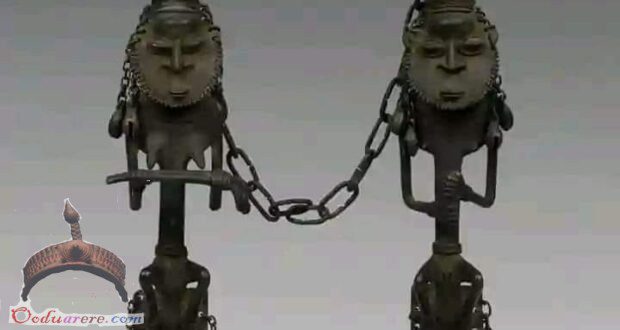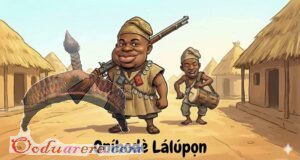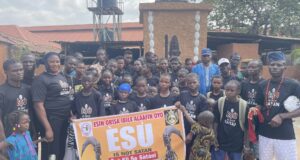Ògbóni; Ògbóràn
Erelú; Àbíyè
Eríwo yà!; À yà gbó, À yà tó!
The old ones; Increase with age. Titled female elders; May children be born to live
The Lord of secrets, descend!; For longevity and prosperity!
Ẹdan Ògbóni is a pair of male and female brass figures with iron stems, usually joined at the top by an iron chain. It is an emblem of membership in the Ògbóni society, which wielded considerable political, judicial, and religious powers among the Yoruba in precolonial times and still does, to some extent, today.
In the past, the society (known as Òṣùgbó among the Ẹ̀gbá and Ìjẹ̀bú Yorùbá) functioned as a town council, a civic court, and an electoral college for selecting a new king and dethroning a bad or unpopular one. It imposed curfews in times of crisis and also executed serious offenders.
Much of the society’s authority derives from its role as the vital link between the community and the Earth that sustains it. Membership, which brings power and prestige, is restricted to a few individuals who have attained distinction in their professions and have proven to be people of high integrity and mature judgment.
In the course of participating in various deliberations, a member gains considerable insights into human nature as well as local politics, traditional lore, religion, and philosophy. Above all, membership provides access to certain knowledge and powers for coping with the vicissitudes of life.
Free-standing versions of the ẹdan pair (see examples below) are called Onílé (Owner of the house) and, sometimes, Onílẹ̀ (Owner of the land). They represent the earth deity on special altars inside the Ògbóni lodge, witnessing the secret proceedings of the society to enforce confidentiality, fair play, and self-discipline. Regardless of size, an altarpiece is considered more powerful than ẹdan because of the sacred substances used in consecrating it.
In essence, the Ògbóni venerates the Earth (Ilẹ̀) to ensure human survival, peace, happiness, and social stability in the community. The desire for longevity and well-being is evident in the choice of brass (idẹ) for the figures and iron (irin) for the stem of ẹdan. Brass is distinctive for its luster and permanence. Moreover, it is sacred to and attracts the blessings of Ọ̀ṣun, the river goddess associated with health, wealth, beauty, and fertility. Iron, on the other hand, is sacred to Ogún, the deity of valour creative energy, industry, hunting, and warfare.
Although it rusts easily if abandoned or buried in the ground, iron is durable when treated, sheathed, or kept in frequent use. One of the strongest metals, it is fabricated into different hardware for hammering, cutting, securing, bracing, and other purposes. The iron stem reinforces the brass figures of ẹdan, indicating the strength, vigour, and “cutting edge” one needs not only to succeed in life but also to live to ripe old age.
This symbolism echoes in the Ògbóni catchword Ogbódirin! (“Age, and still be strong like iron!”), a nickname for Ọbàlùfọ̀n, one of the ancient kings of Ilé-Ifẹ̀ credited with introducing the art of brass casting to the city and reputed to have lived for more than a century. The enduring and dynamic qualities of brass and iron thus buttress the talismanic functions of ẹdan, inspiring the following incantation:
Ẹdan never dies, ẹdan never decomposes
The vulture never dies young…
Never shall we hear that Olódùmarè is dead
Old age abides in ẹdan
May I grow old, and be blessed
For a long time the feet walk on the land.
Reference:
Culled from: African Arts, Vol. 28, No. 1 (Winter, 1995), pp. 36-49+98-100 (Author: Babatunde Lawal)
Images credits:
The University of Iowa Museum of Art Metropolitan Museum of Art, New York
Olobe Yoyon
 Ọmọ Oòduà Naija Gist | News From Nigeria | Entertainment gist Nigeria|Networking|News.. Visit for Nigeria breaking news , Nigerian Movies , Naija music , Jobs In Nigeria , Naija News , Nollywood, Gist and more
Ọmọ Oòduà Naija Gist | News From Nigeria | Entertainment gist Nigeria|Networking|News.. Visit for Nigeria breaking news , Nigerian Movies , Naija music , Jobs In Nigeria , Naija News , Nollywood, Gist and more









